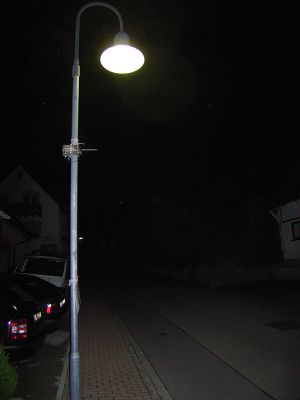The widespread replacement of conventional bulbs in street lighting by energy-saving light-emitting diodes (LEDs) has considerable influence on bats as urban nocturnal hunters. Opportunistic bats lose hunting opportunities whereas light sensitive species benefit. This was shown in a recent study by Christian Voigt and Daniel Lewanzik from the Leibniz Institute for Zoo and Wildlife Research (IZW).
Conventional high pressure mercury bulbs have a broad spectrum of wavelengths, including those in the ultraviolet range. As a consequence, insects are magically attracted to street lighting and indirect light spilling out from houses. Moths, mosquitoes, beetles and other insects are drawn to the light because of the so-called vacuum cleaner effect. They circle around lamps and often become victims of insect-eating predators. For instance, some light-tolerant bat species frequently forage on insect aggregations at lights; for them street lamps are a lit “buffet”. Yet, the new LEDs that are used in street lamps do not emit UV light. Thus, insects ignore them and do not buzz around the lamps anymore. The scientists from IZW therefore studied how the increasing use of LED light bulbs may influence the activity of urban bats.
 |
|
Bat recorder and information flyer attached to a street lamp. The bat recorder automatically detects bats flying past and records their ultrasonic sounds. (Photo credit of Daniel Lewanzik) |
Previously, it was well known that opportunistic species such as pipistrelles and the common noctule tolerate light and hunt even in lit areas in cities at night. Light sensitive species that shun the light such as many mouse-eared bats mainly hunt in dark parks and forests.
For their study, part of the so-called “Loss of the night” project funded by the German Federal Ministry of Education and Research (BMBF), the scientists installed bat recorders on 46 street lamps in six German cities, amongst them Freiburg in the southwest and Berlin. By recording echolocation calls of hunting bats, bat recorders automatically detect the presence of bats at conventional and LED street lamps.
The results were interesting: whereas the activity of the common pipistrelle diminished by 45 % near LED lamps, light sensitive species that usually avoid artificial light increased their activity by a factor of four-and-a-half. A few species such as the Nathusius pipistrelle were not affected at all by the reduced spectrum of wave lengths of the LEDs. “We therefore conclude that bats which are sensitive to light might benefit from the increasing use of LED, but opportunistic species will suffer from it”, says Voigt. The latter will probably have to travel longer distances in order to find sufficient food.
One thing seems to be sure: Bats will adjust their foraging behaviour to the new situation and, therefore, the composition of species within local bat assemblages is likely to change in urban environments. “Both the use of LED lights and the change in activity of bats will have a substantial effect on insect populations, since bats are the top predators for insect populations in the urban environment”, emphasises Voigt.
Will there be more mosquitoes and other insect nuisances in the future? “Yes, this might be the negative side of it”, speculates Voigt. “But there will also be more moths, and thus more pollinators!” More pollinators will also mean a higher production of seeds, to the benefit of plants – an effect that probably no one had thought of when the purpose was to save energy in street lighting.
LEDs use very little energy, thus electricity costs are low. Further, they can be controlled dynamically and dimmed when full intensity is not needed. This sounds like a big benefit – yet it might also turn into a problem. The tendency of people to use LEDs to light every little corner of their house and garden is likely to wipe out any potential energy savings.
This also leads to a steady increase in light pollution. The negative effects of light pollution on human health are already well documented.
“Humans are diurnal creatures and their day-night-rhythm is set by the secretion of hormones such as melatonin”, says Voigt. Numerous studies provide evidence that people working in night shifts have a higher risk of contracting certain types of cancer because artificial light interferes with their biorhythm.
“Meanwhile scientists are seeing more clearly that artificial light does not only affect people but also wildlife and even whole ecosystems”, highlights Christian Voigt.
In November 2016, EUROBATS, an EU-group of experts, will meet at the IZW in Berlin to share their experiences on how bats are affected by artificial light in different EU countries; hopefully this will result in a list of recommendations on how to use artificial light in a wildlife-friendly way. “A general rule is: the less artificial light, the better. One should question the necessity of every single lamp”, Voigt states.
Urban bats have to cope with a double whammy. Not only do some of them lose their hunting opportunities when insects are no longer attracted to street lanterns, but many also lose their roosting sites because of the current promotion of energy efficient houses and with it the efficient insulation of their walls, exterminating bat roosts in buildings.





 CN
TW
EN
CN
TW
EN






